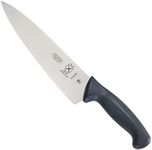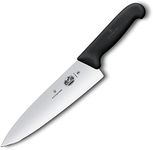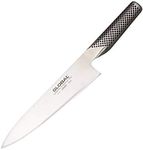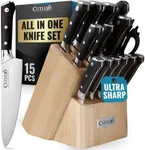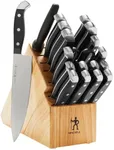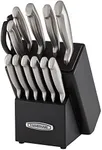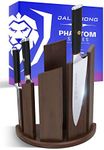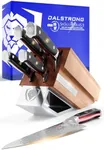Buying Guide for the Best Professional Chef Knives
Choosing the right professional chef knife is crucial for any culinary enthusiast or professional chef. A good knife can make food preparation more efficient, enjoyable, and safe. When selecting a chef knife, it's important to consider several key specifications to ensure you get the best fit for your needs. Here are the main factors to consider and how to navigate them.Blade MaterialThe blade material of a chef knife affects its sharpness, durability, and ease of maintenance. Common materials include stainless steel, carbon steel, and high-carbon stainless steel. Stainless steel is resistant to rust and easy to maintain, making it a good choice for beginners. Carbon steel is very sharp and holds an edge well but requires more maintenance to prevent rust. High-carbon stainless steel combines the best of both worlds, offering sharpness and rust resistance. Choose a material based on your willingness to maintain the knife and your need for sharpness.
Blade LengthBlade length determines the knife's versatility and ease of use. Common lengths range from 6 to 12 inches. Shorter blades (6-8 inches) are easier to control and are suitable for smaller tasks like chopping herbs or slicing small vegetables. Longer blades (10-12 inches) are more versatile and can handle larger tasks like slicing meat or chopping large vegetables. Consider the types of tasks you'll be performing most often and choose a length that feels comfortable in your hand.
Handle MaterialThe handle material affects the knife's comfort, grip, and durability. Common materials include wood, plastic, and composite. Wood handles offer a traditional look and feel but require more maintenance to prevent damage from moisture. Plastic handles are durable and easy to clean but may not provide the same level of grip as other materials. Composite handles combine the benefits of wood and plastic, offering durability and a good grip. Choose a handle material that feels comfortable in your hand and suits your maintenance preferences.
Weight and BalanceThe weight and balance of a chef knife affect how it feels and performs during use. A well-balanced knife will feel comfortable and stable in your hand, making it easier to control. Heavier knives can provide more power for cutting through tough ingredients, while lighter knives offer more precision and reduce fatigue during extended use. Consider your personal preference and the types of tasks you'll be performing to choose a knife with the right weight and balance for you.
Edge TypeThe edge type of a chef knife determines its cutting performance and maintenance requirements. Common edge types include straight, serrated, and granton. Straight edges are versatile and easy to sharpen, making them suitable for most tasks. Serrated edges are ideal for cutting through tough or crusty surfaces but can be more difficult to sharpen. Granton edges have small indentations that reduce friction and prevent food from sticking to the blade, making them great for slicing. Choose an edge type based on the types of ingredients you'll be cutting and your willingness to maintain the edge.
